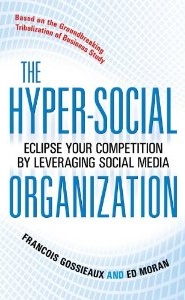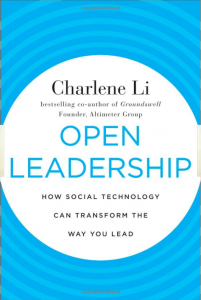 I’ve been looking forward to reading The Hyper-Social Organization since I first heard François Gossieaux and Ed Moran discuss the findings of their “Tribalization of Business” research at a conference two years ago. I wasn’t disappointed. In this groundbreaking book, the authors expand upon ideas laid down in their early research that are both simple to grasp and momentous in their implications.
I’ve been looking forward to reading The Hyper-Social Organization since I first heard François Gossieaux and Ed Moran discuss the findings of their “Tribalization of Business” research at a conference two years ago. I wasn’t disappointed. In this groundbreaking book, the authors expand upon ideas laid down in their early research that are both simple to grasp and momentous in their implications.
The assumption in The Hyper Social Organization is that human beings are basically social animals and that our behavior is fundamentally tribal. Given the opportunity, we seek help from others when making important decisions and willingly assist other members of our tribe. The popularity of social networks and collaborative projects like Wikipedia attests to these instincts.
In a business context, however, tribes have barely been a factor. Our ability to tap into networks of like-minded people has been limited by space and time. The whole relationship between institutions and their constituents is hard-wired around the assumption that people on the consuming end of the transaction are mostly in the dark. This is been a huge advantage to suppliers. Basically, he who shouted the loudest had the edge. That isn’t true any more, though.
Rules Have Changed
In the last five years, the supplier-customer relationship has begun to change fundamentally because of the Internet. Customers today can easily find each other for advice, and that’s exactly what they’re doing. The resulting changes in market dynamics, the authors argue persuasively, will disrupt business at every level. The Hyper-Social Organization is a look ahead at how those disruptions may play out.
Some markets have already seen this shift occur. A friend of mine who manages an auto dealership tells me that many customers today come into the showroom better informed about the vehicle they want to buy than his own salespeople are. As the Internet has created smarter car buyers, auto dealers have had to overhaul their businesses. Most make little margin on new vehicle sales anymore and must take most of their profit from service.
The same dynamic will play out across many more industries, the authors suggest. In markets in which peer information is easily obtained, the vendor becomes nothing more than one more voice in the crowd, and probably not a very important one at that. As companies cede control of the megaphone, they will have to re-examine their entire value proposition and change many of the ways they work.
For example, marketers will no longer be able to push empty messages because they will simply be ignored. The only hope for marketing is to become a valued source of advice. That doesn’t mean publishing more promotional white papers. It means listening to the market and helping customers make wiser decisions, even if that means recommending someone else’s product.
Similarly, sales must evolve into more of a consultation and systems integration role. Ultimately, the authors suggest, sales representatives must be encouraged and actually rewarded for suggesting lower-cost or even competitive products if that advice is in the best interests of the customer. Behavior that is anything less than helpful will be ignored or, even worse, punished in a public forum.
Marketing and sales organizations will both need to adapt to the end of the traditional funnel. Customers will no longer enter the company’s orbit at the early awareness stage; they may not make their first contact until they’re ready to buy. This means marketing materials must be overhauled to address customers who enter the funnel fully informed with information from other sources.
There are implications for the workforce as well. Gossieaux and Moran assert that successful companies will be those that empower their employees to make decisions on behalf of the customer regardless of their formal role in the organization. Among the many examples they cite is JetBlue, which shuns a rule book in favor of five core values — safety, caring, integrity, fun and passion — that each employee is expected to live by. Employees are never punished for making decisions as long as they adhere to those core principles.
Adopting an External Focus
Embracing an outwardly focused, socially active organization will require tolerance for a certain amount of “messiness.” This is inevitable and even desirable as organizations learn to quickly test, assess, fix and discard ideas based upon customer feedback. The good news is that customers can be remarkably tolerant of mistakes as long as businesses seek their input and are transparent and earnest about their motives.
In the end, the rise of social media “is likely to present companies with a critical question that is bound to keep executives busy for the next few years: What business are we in?” These kinds of life-or-death choices will be propelled by the ease with which operations can now be outsourced half a world away. Any line of business that does not provide the opportunity for clear competitive differentiation should be discarded, the authors say. Many companies will find that their only source of sustainable advantage is in customer service, systems integration and innovation. Businesses must effectively become integrators because otherwise their customers will do the integration themselves.
If this sounds like a lot of bad news, it is, but there’s also a silver lining in The Hyper Social Organization. Gossieaux and Moran believe that organizations that embrace the concept of hyper-sociality and involve external constituents at every level can reap enormous benefits. Crowdsourced product development is far cheaper than hiring legions of engineers. Customers who arrive via word-of-mouth recommendation are twice as loyal as those who respond to an ad. In fact, external constituents can take on much of the work that paid employees now do if they are courted appropriately.
Not that this is going to be easy. Twenty years ago, a lot of big computer companies made their money selling hardware. As market forces turned that business into a commodity, they were forced to shed often very large businesses in order to remain viable. It was an agonizing process, but the companies that survived it are more diversified and better prepared for the future. Many didn’t survive, though, and if the scenario that Gossieaux and Moran portray comes to pass, a lot of other organizations are in for the same experience.







 In
In 
